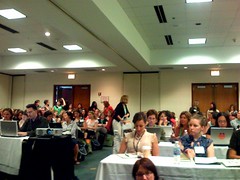Penelope Trunk makes an observation and asks a very enlightened question:
"Instead of worrying about the wage gap let’s worry about the Web 2.0
gap. The second round of the Internet revolution is being run largely
by men. In fact, as tech companies need less and less marketing,
the usual spots for women in tech companies are disappearing. And as
the barrier to entry gets lower and lower, and founders get younger and younger,
the hours people put in to start a company verge on 100 percent of
waking time, something that women seem to be just plain not interested
in doing.I am not sure what should be done about the Web 2.0 gap. I have a
feeling that it ends up getting more and more male-centric — just like
video games. For example, most blogs are aimed at technical types.
(Something we might be able to overcome.) Yet the most prominent blog
ranking site, Technorati, ranks blogs based on how many people link to
them. So a blog catering to people who don’t blog themselves would be
ranked lower in the blogosphere. The subtle burying of women’s voices
online.I’m not sure if it’s a big deal or not. But I am definitely sure the
time gap and the Web 2.0 gap are having more impact on the business
opportunities women see than that statistically irrelevant pay gap is.
It’s just that the mainstream media is accustomed to writing about pay
gap, and not about who is playing poker with the founders of Digg and who is playing Xbox with the founders of Reddit."
Interesting perspective. (I’m still mulling this over and need to check some of the assertions above before buying in wholesale, but this sounds plausible at first blush.) Your thoughts?




 Just arrived in Chicago and am heading into the first session at BlogHer 2007. Will be liveblogging some sessions later; other folks are
Just arrived in Chicago and am heading into the first session at BlogHer 2007. Will be liveblogging some sessions later; other folks are 


